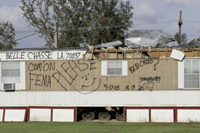Hurricane Katrina has left in its wake a heightened awareness of the many IT-related gaps in emergency response systems in the Gulf Coast region and, most likely, in communities throughout the nation. Shortcomings are rampant among systems handling emergency communications, disaster resource management, situational awareness, patient tracking, disease surveillance and post-disaster family reunification, experts said.Katrina's devastation was exacerbated by the failure of basic electrical power, telephone and Internet services, which has spurred interest in creating backup systems to restore such services quickly after a catastrophe.'Until now, there has not been much investment related to catastrophic failures in which the infrastructure is destroyed,' said James Jay Carafano, a senior fellow at the Heritage Foundation think tank in Washington.Post-Katrina, however, there is greater motivation to plan for backup communications systems, possibly with wireless technology, he said.But Charles Werner, fire chief for Charlottesville, Va., who has been an adviser to DHS on linking radio systems among first responders, cautioned against too much emphasis on redundancy and secondary systems.'It seems critical to re-examine the thought of putting money into any secondary [system] when the focus must be placed on bringing primary radio systems to an acceptable performance level,' Werner said.Experts said the incompatibility of police, fire and EMS radios'making it difficult to talk with each other and with first responders in nearby towns'slowed the Katrina response and is a widespread problem throughout the country.With or without such backup systems, Katrina also has heightened awareness of the need for more advanced IT tools to coordinate disaster response.For example, IT systems to re- route telephone calls might have benefited people trying to reach 911 call centers.After Katrina hit, 'people were calling 911 and no one was answering,' said David Aylward, director of ComCare, a nonprofit emergency communications group helping the Homeland Security Department write open standards for data programs for first responders. 'There was no system in place to roll the calls over to a 911 system that was still operating.'Also needed are IT systems to track available disaster-related resources, such as hospital beds, water supplies, vehicles, skilled personnel, food, boats, cots, medical supplies, and search and rescue equipment. Werner said he was frustrated in trying to volunteer personnel and equipment following Katrina because there was no central online system coordinating the requests.'The problem is that requests for help were going out to multiple states,' Wer- ner said. 'By the time you can locate the ma- terials, you find out the request already has been filled.'The Emergency Interoperability Consortium, a nonprofit group of industry and public agencies, is working with DHS to develop data interoperability standards for a resource tracking system.According to chairman Matt Walton, the system will provide inventories of disaster-related assets and resources, such as personnel, equipment and supplies. It should be ready for public use in six to nine months, he said.'This resource will facilitate, for the first time, the exchange of information about assets'fire trucks, bomb-sniffing dogs, helicopters, etc.'across all the different systems out there.Clearly, in context of a massive event, the information has to come together to be shared rapidly and efficiently,' Walton said. 'This would have had a tremendous impact [immediately] following Katrina.'The consortium helped develop the Common Alerting Protocol, an Extensible Markup Language standard for emergency warnings and alert messages, as well as the Distribution Element, another XML standard for use as a common wrapper to send files and data'such as maps, video files and photographs'across disparate systems and applications. The distribution element currently is being reviewed by the Organization for the Ad- vancement of Structured Information Standards, a nonprofit standards-making group.In addition to tracking resources, regional IT systems are needed for situational awareness in a disaster, with geographic maps showing affected areas, road and hospital closures, location of personnel and resources, and the like, Aylward said.The ComCare alliance has been working on developing open IT standards for such a system for medical facilities, called HaveBed, to provide real-time information on the availability of hospital beds, equipment, personnel and supplies. It can be used post-disaster as well as for daily communications among hospitals, emergency managers and 911 centers, he said.Ideally, communities ought to have IT systems in place to keep track of people who are injured or seriously ill'both in and out of hospitals'as they are evacuated to other locations across the country following the disaster, said Dr. Jeff Elting, emergency preparedness director for the District of Columbia Hospital Association in Washington. The systems would indicate where patients were taken, in what condition they were received and what treatments they received, and provide for notification of the families, he said.'Patient tracking is a challenge'especially for people who are not hospitalized,' Elting said.IT systems to facilitate family reunification following a major disaster also should be a high priority, Carafano said. While reunification services and Web sites exist, there is a need for further development and more widespread usage, he said.When IT gaps became apparent after Katrina, some IT systems were created quickly to fill the niches.For example, medical IT company EMSystem LLC of West Allis, Wis., donated software to federal health authorities to set up a medical resource inventory system and medical syndromic surveillance system in the disaster region.A syndromic surveillance system allows health centers, hospitals and medical intake centers to report various symptoms reported by patients'such as high fevers, diarrhea and difficulty breathing'to a central monitoring agency to help provide an early warning of major disease outbreaks.Also, public health officials created an online pharmacy-coordinating system so physicians treating evacuees in other states could use a central repository of information, Aylward said.'They were able to put together a database in 10 days,' he said.
Tracking patientsAlice Lipowicz is a staff writer for GCN's sister publication Washington Technology.







